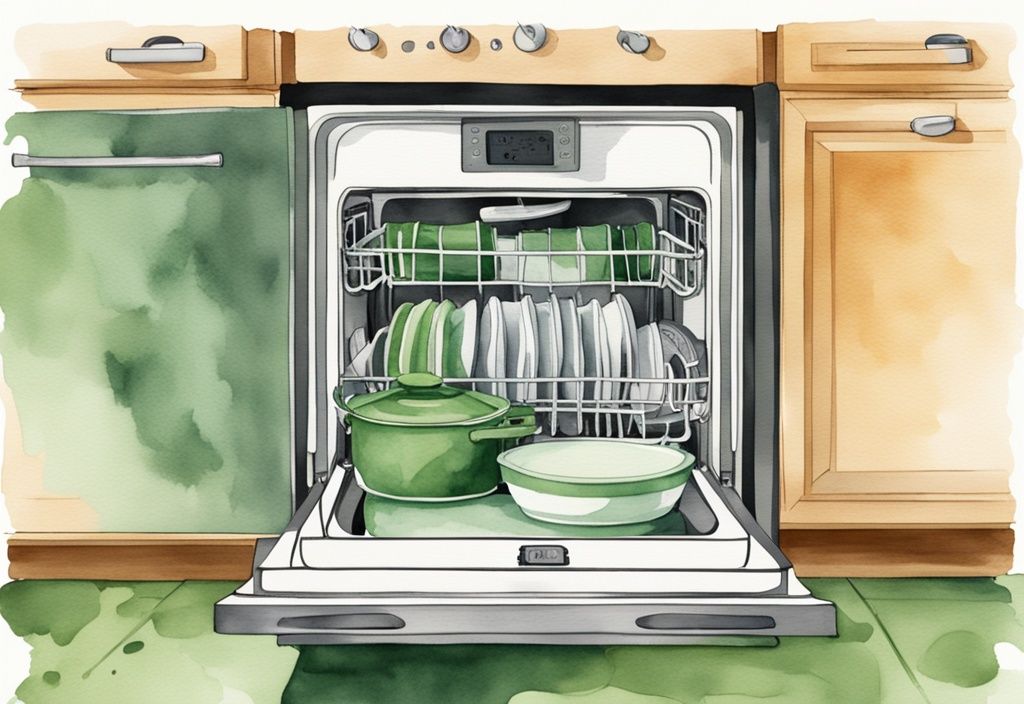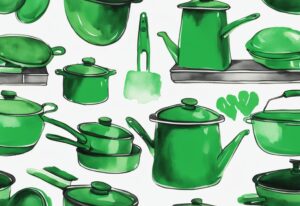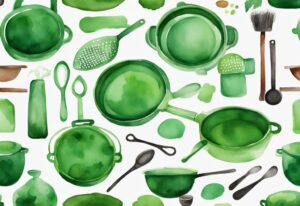Is a Crock Pot Dishwasher Safe? Find Out Here for Clean Cooking
Have you ever wondered, “Is my crock pot dishwasher safe?” I know I’ve been there! As someone who adores the convenience of a crock pot, I also understand the uncertainty when it comes to giving it a thorough clean. Choosing the wrong cleaning method can harm your appliance and potentially void its warranty.
In this guide, I have compiled essential tips on the dos and don’ts of crock pot care. We’ll uncover which parts can bravely weather the dishwasher and how to handle the sensitive components that can’t. This way, you won’t just be saving time, but also enhancing your cookware’s lifespan, ensuring its part in numerous hearty meals ahead.
Join me on this journey for understanding your crock pot better. Let’s foster peace of mind in our non-toxic, healthy homes, one small step at a time!
Determining the Dishwasher Safety of Crock Pot Components
Checking Manufacturer’s Instructions
Understanding whether your crock pot components are dishwasher safe begins with checking the user manual or the manufacturer’s guidelines. These instructions usually specify which parts can safely go into the dishwasher, as this can vary significantly by model. Keeping to these guidelines is crucial for maintaining the longevity and functionality of your crock pot.
If you no longer have the manufacturer’s instructions handy, a removable inner pot is often a good indicator that it might be dishwasher safe. To be sure, visit the manufacturer’s website or reach out to their customer service for specifics about your model. Importantly, never place any parts containing electric wiring or components in the dishwasher. This can lead to irreparable damage and pose a severe safety risk.
Which Crock Pot Components Are Normally Dishwasher Safe
Typically, the ceramic insert and most glass lids of crock pots are dishwasher safe, making for easy and efficient cleaning. Many manufacturers explicitly label their products as “dishwasher safe,” indicating that the ceramic pot and glass lid can withstand the dishwasher’s environment without damage. These components can usually endure multiple wash cycles while maintaining their functionality and aesthetic appeal.
Double-checking for any specific notes or stickers on the components themselves can also provide clarity. If in doubt, it’s often safe to assume that the ceramic insert and glass lid are dishwasher safe. However, reviewing any available guidelines is still wise to ensure the best care for your crock pot.
Crock Pot Parts That Should Not Go in the Dishwasher
The outer heating base of the crock pot, which contains the unit’s electrical parts, should never be submerged in water or placed in the dishwasher. Exposure to water can lead to electrical damage and compromise the safety of the appliance. It’s best to clean these parts manually using a damp cloth or sponge, ensuring the cleaning solution doesn’t seep into any electrical components.
For crock pots with digital or electronic parts, hand-washing is almost always the recommended method. Placing these parts in the dishwasher can result in malfunction or complete failure due to water exposure.
By following proper cleaning practices for these specific components, you can avoid unnecessary damage and extend the life of your crock pot, which is essential for maintaining kitchen safety and ensuring optimal performance of your equipment. For more information on kitchen equipment maintenance, visit this resource.
Safe Cleaning Tips for Dishwasher Safe Crock Pot Parts
To keep your beloved crock pot in tip-top shape, let’s explore some practical cleaning advice. These tips will help you maintain both the functionality and aesthetic of your kitchen companion, ensuring it serves you well for a long time.

Cleaning the Dishwasher-Safe Ceramic Insert
Allow the ceramic insert to cool down completely before placing it in the dishwasher. Thermal shock can crack the ceramic, and nobody wants that! Cleaning the insert shortly after use prevents food residue from hardening, making it much easier to wash away.
Correct Positioning in the Dishwasher
Place the dishwasher-safe utensils on the top rack. This position reduces exposure to the intense heat from the bottom of the dishwasher, safeguarding your crock pot components from potential damage.
Keeping the Ceramic Coating Intact
For stubborn, baked-on residues, a non-abrasive scrubber is your best friend. Abrasive tools can scratch and damage the ceramic surface. Frequent dishwasher cycles might wear down the ceramic coating over time, so hand-washing is often a safer bet. Hand-washing helps maintain the integrity of the coating, extending the life of your crock pot.
Ensuring the Glass Lid Survives the Dishwasher
Handle the glass lid with care in the dishwasher. Avoid using the heated dry option as high heat can cause the glass to crack or warp. Heavy-duty dishwashing cycles might lead to slight discoloration of the lid over time. While this doesn’t affect functionality, it can alter the appearance.
Recommended Washing Temperatures and Settings
Ceramic parts are robust enough to withstand high washing temperatures. A standard dishwasher cycle should be fine. However, glass lids are best cleaned on regular cycles, avoiding high heat dry settings. This gentler approach preserves both the lid’s integrity and the overall aesthetic of your appliance.
Manual Cleaning Guide for Non-Dishwasher Safe Crock Pot Parts
Crock pots are a cherished staple in many kitchens, offering the convenience of slow-cooking delicious meals. However, to keep your crock pot in optimal condition, understanding how to clean the non-dishwasher safe parts is crucial. This section will guide you through safely cleaning these essential components.
Taking Care of the Electrical Outer Heating Base
The outer heating base of your crock pot should never be placed in a dishwasher or submerged in water due to its electrical components. Spraying or splashing water can damage these parts, rendering your appliance unsafe for further use.
Method for Safe and Effective Cleaning
To clean the heating base safely and effectively, use a damp cloth or a sponge. Ensure the cloth or sponge is not dripping wet. Gently wipe the surface to remove any food residues, making sure to avoid any electrical outlets or controls. For tougher stains, a soft brush can help, but avoid scrubbing too aggressively to protect the finish and the unit’s integrity.
How to Clean Non-Stick Coated Inserts
Non-stick coated inserts require special care to maintain their coating and longevity. Hand washing with mild detergent and warm water is the safest approach. This gentle method prevents damage to the coating which can occur through harsh cleaning agents or abrasive scrubbers. After washing, rinse the insert thoroughly and dry it with a soft cloth to prevent water spots and lingering moisture.
Some non-stick coatings come with specific cleaning instructions from the manufacturer. Always refer to these guidelines to ensure you’re not voiding any warranties or inadvertently causing damage. This is especially crucial if your crock pot’s manufacturer has outlined unique precautions or recommended cleaning tools. Following these steps will ensure your non-stick insert remains functional and in excellent condition for many years.
By adhering to these manual cleaning methods, you can prolong the life of your crock pot and preserve its effectiveness, ensuring each use is as reliable and safe as the first. Proper care and maintenance are key to utilizing your appliances to their fullest potential.

Manufacturer’s Guidelines and Warranties
Handling your crock pot according to the manufacturer’s guidelines is crucial to maintaining its warranty. The warranty typically covers defects in materials and workmanship under normal usage. However, improper use like putting non-dishwasher-safe parts in the dishwasher could void your warranty. This brings us to the vital question: is a crock pot dishwasher safe?
What Your Warranty Covers and Requires
One thing I’ve learned on my journey to a non-toxic lifestyle is the importance of adhering to the manufacturer’s guidelines. These guidelines are in place not just to ensure your crock pot performs optimally but also to maintain the validity of its warranty. Warranties usually cover defects in materials and workmanship under regular usage. However, deviating from the recommended use—such as putting non-dishwasher-safe components in the dishwasher—can void this coverage.
So, is a crock pot dishwasher safe? This question deserves careful consideration.
Generally speaking, the ceramic insert and glass lid of many crock pots are labeled as dishwasher safe by their manufacturers. However, this isn’t a universal truth. Always consult the specific manufacturer’s instructions to verify which parts of your particular crock pot are safe for the dishwasher.
Using non-dishwasher-safe components in a dishwasher, such as the outer heating base or parts with electronic components, can lead to severe damage. This misuse is typically a valid reason for voiding the warranty, as you’re deviating from the prescribed usage guidelines.
If you’ve misplaced the manufacturer’s instructions, don’t worry. The best course of action is to visit the manufacturer’s website or reach out to their customer service for guidance. They can help you confirm whether your specific crock pot model can go in the dishwasher. Ignoring these guidelines can result in unnecessary repair costs or the need to replace your crock pot entirely, expenses that won’t be covered due to a warranty breach.
In summary, to sustain the validity of your crock pot’s warranty, always adhere to the manufacturer’s instructions regarding dishwasher use. This ensures the durability and proper functioning of your crock pot while keeping you covered under the warranty for any unforeseen defects or issues.
Remember: Staying informed and careful about how you use and care for your appliances keeps them running smoothly while protecting your investment.
Additional Ways to Prolong the Life of Your Crock Pot
The Advantages of Hand-Washing
Hand-washing a crock pot can be a more thoughtful choice compared to using a dishwasher. This method is gentle, reducing the risk of chipping the ceramic coating, which, in turn, ensures the longevity of your crock pot. By hand-washing, you also gain the advantage of meticulously cleaning those hard-to-reach areas, minimizing scratches or other damage. So, when pondering if a crock pot is dishwasher safe, hand-washing often emerges as the safer and more nurturing option.
Avoiding Damage from Abrasive Cleaners
Many manufacturers suggest steering clear of abrasive cleaners or tools, as they can degrade the protective layers, scratch the ceramic, and affect non-stick functionalities. These harsh cleaners might void warranties and lower the appliance’s effectiveness. Opt for mild detergents coupled with soft cloths or sponges instead. This gentler approach is particularly important when considering if a crock pot is dishwasher safe since inappropriate cleaning methods can compromise the device’s performance.
The Importance of Proper Drying Before Storage
Ensuring your crock pot and lid are thoroughly dry before storing them is key to preventing moisture buildup, which can cause mold or mildew. Proper drying not only extends the life of your kitchen tools but also maintains a hygienic environment. Whether you hand-wash or use a dishwasher (for models deemed dishwasher safe), leave the components in a well-ventilated area to air dry completely. This simple habit can notably prolong your crock pot’s life, preparing it for the next culinary adventure.
FAQ
Can I put the ceramic insert of the crock pot in the dishwasher?
Yes, the ceramic insert is generally dishwasher safe. However, it’s always best to confirm with the user manual or manufacturer’s instructions. This ensures you’re following the recommended guidelines tailored specifically for your crock pot model.

Can the glass lid of the crock pot go in the dishwasher?
Most glass lids that come with crock pots are dishwasher safe. However, to prevent any potential damage, avoid using the heated dry option in the dishwasher. It’s an easy step that can prolong the lifespan of your crock pot’s glass lid.
What if I lost the manufacturer’s instructions?
If you’ve misplaced the manufacturer’s instructions, don’t worry. A removable inner pot generally indicates that the set is dishwasher safe. For added reassurance, check the manufacturer’s website or reach out to their customer service for confirmation.
Why should the heating base not go in the dishwasher?
The outer heating base contains electrical parts that can be damaged if submerged in water or placed in a dishwasher. Keeping it dry and clean with a damp cloth is the best way to maintain its functionality and safety.
How should I clean stuck-on food from my crock pot?
For cleaning stuck-on food, start by soaking the pot in warm, soapy water. This helps loosen the residue. Then, use a non-abrasive scrubber to avoid scratching the ceramic surface. Patience and gentle care can go a long way in keeping your crock pot in tip-top shape.
Conclusion
Many people wonder, “Is a crock pot dishwasher safe?” As a fellow enthusiast of non-toxic living, I understand the importance of knowing how to clean our kitchen appliances safely.
- Crock Pot Parts: The ceramic insert and glass lid of many crock pots are often labeled as dishwasher safe. However, it is crucial to refer to the manufacturer’s guidelines to be certain. Each crock pot model has specific instructions regarding which parts are safe for the dishwasher.
- Heating Base: The outer heating base should never be placed in the dishwasher or submerged in water due to its electrical components. A damp cloth is your best friend here, ensuring the base is safely cleaned without causing any damage.
Personally, I’ve found that proper cleaning and maintenance not only ensure my crock pot’s safe use but also extend its lifespan. By following these recommendations, you can maintain your crock pot in optimal condition, preventing any damage.
It’s also essential to avoid abrasive cleaners and ensure the parts are completely dry before storing them. This practice helps prevent issues like mold and mildew, which can compromise your cooking experience and health.
In summary, while some components of a crock pot are designed to be dishwasher safe, always consulting the user manual or manufacturer’s instructions is the safest practice. This approach will keep your crock pot in good shape and ensure you continue to enjoy safe, healthy meals prepared with it.
Remember, our goal is not just to maintain our crock pots but to embrace a lifestyle that is healthier for both us and the environment. Proper care and attention to our kitchen tools are just one of the many steps on this rewarding journey.
Hi, I’m Olivia Green, the voice behind nontoxicways.com. I’m passionate about helping you make the shift to a healthier, non-toxic lifestyle without feeling overwhelmed. I love sharing my personal journey, from small changes to big transformations, along with practical tips that make it all feel doable. My goal is to inspire and guide you toward a lifestyle that benefits both your well-being and the planet. Let’s take this journey together, one simple step at a time!














Post Comment